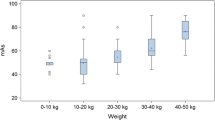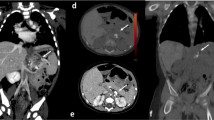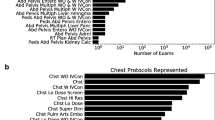Abstract
Background
Before introducing 70-kVp settings in the low-kilovoltage strategies for pediatric examinations, it was mandatory to demonstrate, at similar dose levels, an equivalence of image quality at 70 kVp and 80 kVp.
Objective
To assess image quality of chest CT examinations acquired at 70 kVp in comparison with standard scanning at 80 kVp.
Materials and methods
We prospectively evaluated 129 children with a 70-kVp scanning protocol (group 1). All scanning parameters were kept similar to those usually selected for pediatric standard 80-kVp protocols, except the milliamperage increased by a factor of 1.6 to maintain comparable radiation dose. Image quality of group 1 examinations was compared to that of a paired population scanned at 80 kVp (group 2). The noninferiority hypothesis was fixed at 10% of the mean level of image noise.
Results
There was no significant difference in the mean dose length product (DLP) and the volume computed tomography dose index (CTDIvol) between the groups (DLP: 20.5 ± 5.8 mGy.cm [group 1] vs. 19.7 ± 7.6 mGy.cm [group 2]; P = 0.06) (CTDIvol: 0.8 ± 0.1 mGy [group 1] vs. 0.8 ± 0.18 mGy [group 2]; P = 0.94). The mean of differences in image noise between group 1 and group 2 examinations was −1.38 (−2.59; −0.18), verifying the noninferiority hypothesis. Subjective image quality did not significantly differ between group 1 and group 2 examinations (P = 0.18).
Conclusion
At equivalent radiation dose levels, 70-kVp protocols provide similar image quality to that achievable at 80 kVp.







Similar content being viewed by others
References
Nievelstein RAJ, van Dam IM, van der Molen AJ (2010) Multidetector CT in children: current concepts and dose reduction strategies. Pediatr Radiol 40:1324–1344
Brenner D, Elliston C, Hall E et al (2001) Estimated risks of radiation-induced fatal cancer from pediatric CT. AJR Am J Roentgenol 176:289–296
Hall EJ, Brenner DJ (2008) Cancer risks from diagnostic radiology. Br J Radiol 81:362–378
Euratom FP6 project: safety and efficacy in computed tomography (CT): a broad perspective (2005–2007) AZ: FP6/002388. http://cordis.europa.eu/fetch?CALLER=FP6_PROJ&ACTION=D&DOC=4&CAT=PROJ&QUERY=013543d2b76d:3023:226b4e6d&RCN=74114
Siegel MJ, Schmidt B, Bradley D et al (2004) Radiation dose and image quality in pediatric CT: effect of technical factors and phantom size and shape. Radiology 233:515–522
Herzog C, Mulvihill DM, Nguyen SA et al (2008) Pediatric cardiovascular CT angiography: radiation dose reduction using automatic anatomic tube current modulation. AJR Am J Roentgenol 190:1232–1240
Frush DP (2011) Radiation, thoracic imaging and children: radiation safety. Radiol Clin N Am 49:1053–1069
Singh S, Kalra MK, Moore MA et al (2009) Dose reduction and compliance with paediatric CT protocols adapted to patient size, clinical indication, and number of prior studies. Radiology 252:200–208
Kroft LJ, Roelofs JJ, Geleijns J (2010) Scan time and patient dose for thoracic imaging in neonates and small children using axial volumetric 320-detector row CT compared to helical 64-, 32-, and 16-detector row CT acquisitions. Pediatr Radiol 40:294–300
Schmidt B, Saba OI, Banckwitz R et al (2010) Assessment of a 70kV acquisition mode for pediatric CT scanning. Presented at: Radiological Society of North America 2010 Scientific Assembly and Annual Meeting, Chicago
Yu L, Li H, Fletcher JG et al (2010) Automatic selection of tube potential for radiation dose reduction in CT: a general strategy. Med Phys 37:234–243
Gnannt R, Winklehner A, Goetti R et al (2012) Low kilovoltage CT of the neck with 70 kVp: comparison with a standard protocol. AJNR Am J Neuroradiol 33:1014–1019
Santangelo T, Colas L, Niemann T et al (2013). Radiation dose levels in pediatric chest CT: experience in 506 children evaluated with dual-source CT (B0729). Insights Imaging 4(Suppl 1):145–384
Goo HW (2011) Individualized volume CT dose index determined by cross-sectional area and mean density of the body to achieve uniform image noise of contrast-enhanced pediatric chest CT obtained at variable kV levels and with combined tube current modulation. Pediatr Radiol 41:839–847
Bongartz G, Golding SJ, Jurik AG et al (2004) European guidelines for multislice computed tomography. Funded by the European Commission. Contract number FIGM-CT2000-20078-CT-TIP. March 2004. Available at www.msct.eu
Committee for Proprietary Medicinal Products (CPMP), European Agency for the Evaluation of Medicinal Products (EMEA) (2001) Points to consider on switching between superiority and noninferiority. Br J Clin Pharmacol 52:223–228
Lee T, Tsai IC, Fu YC et al (2006) Using multidetector-row CT in neonates with complex congenital heart disease to replace diagnostic cardiac catheterization for anatomical investigation: initial experiences in technical and clinical feasibility. Pediatr Radiol 36:1273–1282
Singh S, Kalra MK, Gilman MD et al (2011) Adaptive statistical reconstruction technique for radiation dose reduction in chest CT: a pilot study. Radiology 259:565–573
Kim JE, Newman B (2010) Evaluation of a radiation dose reduction strategy for pediatric chest CT. AJR Am J Roentgenol 194:1188–1193
Schneeweiss H, Komlos J, Ahmad AS (2010) Symmetric and asymmetric rounding: a review and some new results. Adv Stat Anal 94:227–247
Shrimpton PC, Hillier MC, Lewis MA et al (2006) National survey of dose from CT in the UK: 2003. Br J Radiol 79:968–980
Frush DP, Herlong JR (2005) Pediatric thoracic CT angiography. Pediatr Radiol 35:11–25
Yu L, Bruesewitz MR, Thomas KB et al (2011) Optimal tube potential for radiation dose reduction in pediatric CT: principles, clinical implementations, and pitfalls. Radiographics 31:835–848
Lee SH, Kim MJ, Yoon CS et al (2012) Radiation dose reduction with the adaptive statistical iterative reconstruction (ASIR) technique for chest CT in children: an intra-individual comparison. Eur J Radiol 81:934–938
Mieville FA, Gudinchet F, Rizzo E et al (2011) Paediatric cardiac CT examinations. Impact of the iterative reconstruction method ASIR on image quality: preliminary findings. Pediatr Radiol 41:1154–1164
Cardinal HN, Holdsworth DW, Drangova M et al (1993) Experimental and theoretical X-ray imaging performance comparison of iodine and lanthanide contrast agents. Med Phys 20:15–31
Paul JF, Rohnean A, Elfassy E et al (2011) Radiation dose for thoracic and coronary step-and-shoot CT using a 128-slice dual-source machine in infants and small children with congenital heart disease. Pediatr Radiol 41:244–249
Conflicts of interest
We acknowledge that Martine Remy-Jardin received research grants from Siemens Healthcare, Erlangen, Germany. Jacques Remy is a consultant for Siemens Healthcare.
Author information
Authors and Affiliations
Corresponding author
Rights and permissions
About this article
Cite this article
Niemann, T., Henry, S., Duhamel, A. et al. Pediatric chest CT at 70 kVp: a feasibility study in 129 children. Pediatr Radiol 44, 1347–1357 (2014). https://doi.org/10.1007/s00247-014-3027-8
Received:
Revised:
Accepted:
Published:
Issue Date:
DOI: https://doi.org/10.1007/s00247-014-3027-8




